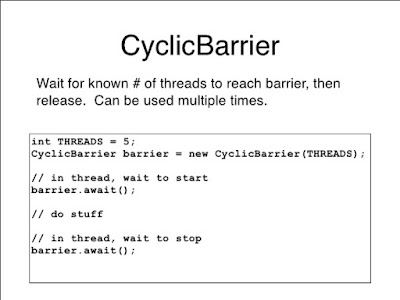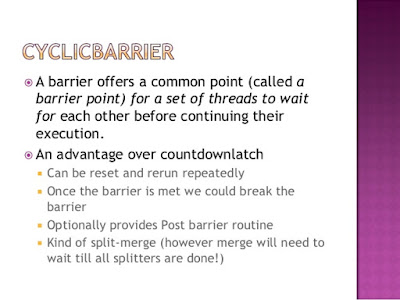This is the second part of my concurrency tutorial, in
first part
, you have learned how to use
CountDownLatch
and in this part, you will learn
how to use CyclicBarrier class in Java
.
CyclicBarrier
is another concurrency utility introduced in Java 5 which is used when a number of threads (also known as parties) wants to wait for each other at a common point, also known as barrier before starting processing again. Its similar to
CountDownLatch
but instead of calling
countDown()
each thread calls
await()
and when last thread calls
await()
which signals that it has reached barrier, all thread started processing again, also known as barrier is broken. You can use
CyclicBarrier
wherever you want to use
CountDownLatch
, but opposite is not possible because you can not reuse the latch once count reaches to zero. Some of the common usage of
CyclicBarrier
is in writing unit test for concurrent program, to simulate concurrency in test class or calculating final result after
individual
task has completed.
In this tutorial, I will show you an example of how four worker thread waits for other before starting again. As I told in previous article , concurrency is hard to master, sometime even if you read couple of articles on one topic, you don't get what you are looking for. If you understand how and where to use CountDownLatch and CyclicBarrier , then only you will feel confident. Books are also good for mastering concurrency, and one book in particular is very useful to learn multi-threading and concurrency in Java. You guessed it right, I am talking about Java Concurrency in Practice by Brian Goetz , I strongly recommend this book to anyone seriously wants to master threading and concurrency in Java. If you can't get first hand, get second hand, if you can't buy then lend it from library but if you are serious about Java concurrency, you should read it.
In our example setup, we have given each worker thread a different name, starting from PARTY-1 to PARTY-4 just to have a meaningful output. We have passed same instance of cyclic barrier to each thread. If you look at their Runnable implementation , you will find that each party sleep for some seconds and then call await() method on barrier. The sleep is introduced so that every thread calls barrier method after some time. Sleep time is also on increasing order, which means PARTY-4 should be the last one to call await. So as per our theory, every thread (party) should wait after calling await() until the last thread (PARTY-4) calls the await() method, after that every thread should wake up and start processing. Of-course they need to compete for CPU and they will start running once they got the CPU from thread scheduler, but what is more important is that once barrier is broken, each thread (party) becomes eligible for scheduling . By the way, you can reuse the barrier even after its broken this is where CyclicBarrier is different than CountDownLatch .
If you look at the output is exactly matches with our theory. Each worker thread (PARTY 1 - 3) calls the await() method and then they stop processing until PARTY-4 comes and call await() method, after that every thread gets a wake up call and started execution again, depending upon when they are scheduled by Java thread scheduler. This is how CyclicBarrier class works. You can still reuse the barrier object and if a thread calls barrier.await() again, it will wait for four worker thread before it gets wake up call. By the way, If barrier is broken before a thread calls await() then this method will throw BrokenBarrierException .
In this tutorial, I will show you an example of how four worker thread waits for other before starting again. As I told in previous article , concurrency is hard to master, sometime even if you read couple of articles on one topic, you don't get what you are looking for. If you understand how and where to use CountDownLatch and CyclicBarrier , then only you will feel confident. Books are also good for mastering concurrency, and one book in particular is very useful to learn multi-threading and concurrency in Java. You guessed it right, I am talking about Java Concurrency in Practice by Brian Goetz , I strongly recommend this book to anyone seriously wants to master threading and concurrency in Java. If you can't get first hand, get second hand, if you can't buy then lend it from library but if you are serious about Java concurrency, you should read it.
CyclicBarrier Example in Java
You just cannot understand concurrency without an example, seeing is believing here. It's difficult to comprehend words like worker thread, parties, waiting for each other at a point, until you see it live in action. In this program, we have four worker threads and one main thread, which is running your main method. We have an object of CyclicBarrier , which is initialized with parties = 4, the argument we passed in CyclicBarrier constructor is nothing but number of party, which is actually number of threads to stop at barrier. The barrier will not be broken until all parties are arrived. A party (thread) is said to be arrived with it call barrier.await() method.In our example setup, we have given each worker thread a different name, starting from PARTY-1 to PARTY-4 just to have a meaningful output. We have passed same instance of cyclic barrier to each thread. If you look at their Runnable implementation , you will find that each party sleep for some seconds and then call await() method on barrier. The sleep is introduced so that every thread calls barrier method after some time. Sleep time is also on increasing order, which means PARTY-4 should be the last one to call await. So as per our theory, every thread (party) should wait after calling await() until the last thread (PARTY-4) calls the await() method, after that every thread should wake up and start processing. Of-course they need to compete for CPU and they will start running once they got the CPU from thread scheduler, but what is more important is that once barrier is broken, each thread (party) becomes eligible for scheduling . By the way, you can reuse the barrier even after its broken this is where CyclicBarrier is different than CountDownLatch .
import java.util.concurrent.BrokenBarrierException; import java.util.concurrent.CyclicBarrier; /** * Java Program to demonstrate how to use CyclicBarrier, Its used when number of threads * needs to wait for each other before starting again. * * @author Javin Paul */ public class HelloHP { public static void main(String args[]) throws InterruptedException, BrokenBarrierException { CyclicBarrier barrier = new CyclicBarrier(4); Party first = new Party(1000, barrier, "PARTY-1"); Party second = new Party(2000, barrier, "PARTY-2"); Party third = new Party(3000, barrier, "PARTY-3"); Party fourth = new Party(4000, barrier, "PARTY-4"); first.start(); second.start(); third.start(); fourth.start(); System.out.println(Thread.currentThread().getName() + " has finished"); } } class Party extends Thread { private int duration; private CyclicBarrier barrier; public Party(int duration, CyclicBarrier barrier, String name) { super(name); this.duration = duration; this.barrier = barrier; } @Override public void run() { try { Thread.sleep(duration); System.out.println(Thread.currentThread().getName() + " is calling await()"); barrier.await(); System.out.println(Thread.currentThread().getName() + " has started running again"); } catch (InterruptedException | BrokenBarrierException e) { e.printStackTrace(); } } } Output main has finished PARTY-1 is calling await() PARTY-2 is calling await() PARTY-3 is calling await() PARTY-4 is calling await() PARTY-4 has started running again PARTY-1 has started running again PARTY-2 has started running again PARTY-3 has started running again
If you look at the output is exactly matches with our theory. Each worker thread (PARTY 1 - 3) calls the await() method and then they stop processing until PARTY-4 comes and call await() method, after that every thread gets a wake up call and started execution again, depending upon when they are scheduled by Java thread scheduler. This is how CyclicBarrier class works. You can still reuse the barrier object and if a thread calls barrier.await() again, it will wait for four worker thread before it gets wake up call. By the way, If barrier is broken before a thread calls await() then this method will throw BrokenBarrierException .
When to use CyclicBarrier in Java Program
It is a very useful class and have several practical uses. You can use this to perform final task once individual task are completed. You can use it to write some unit tests to check some variants as well. Remember you can reuse the barrier as opposed to latch. One a side note, this CyclicBarrier example is also a good example of how to catch multiple exception in one catch block in Java, a feature introduced in JDK 1.7 . You can see that we have two unrelated exceptions InterruptedException and BrokenBarrierException , but we have caught then in same catch block, because of this feature, this code requires Java 7 to run. If you are not using JDK 7 then just use two catch block instead of one.That's all about how to use CyclicBarrier in Java. In this CyclicBarrier Example you have not only learned how to use CyclicBarrier but also when to use it. You should use it when one thread needs to wait for a fixed number of thread before starting an event e.g. Party. You can use CyclicBarrier to write concurrency unit test and implement generic algorithms in Java




 本文详细介绍了Java中的CyclicBarrier类,包括其原理、如何使用以及何时使用。通过一个具体的例子展示了四个工作线程等待彼此到达某个点后再开始再次运行的过程。此外,文章还探讨了CyclicBarrier在并发编程中的实际应用,如编写并发测试、模拟并发环境以及计算多个任务完成后结果等。同时,解释了如何重用CyclicBarrier对象,以及如何在Java 7及以上版本中捕获多个异常在一个catch块中。
本文详细介绍了Java中的CyclicBarrier类,包括其原理、如何使用以及何时使用。通过一个具体的例子展示了四个工作线程等待彼此到达某个点后再开始再次运行的过程。此外,文章还探讨了CyclicBarrier在并发编程中的实际应用,如编写并发测试、模拟并发环境以及计算多个任务完成后结果等。同时,解释了如何重用CyclicBarrier对象,以及如何在Java 7及以上版本中捕获多个异常在一个catch块中。


















 699
699

 被折叠的 条评论
为什么被折叠?
被折叠的 条评论
为什么被折叠?








